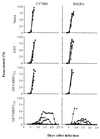Protective immune responses to the 42-kilodalton (kDa) region of Plasmodium yoelii merozoite surface protein 1 are induced by the C-terminal 19-kDa region but not by the adjacent 33-kDa region
- PMID: 11796616
- PMCID: PMC127676
- DOI: 10.1128/IAI.70.2.820-825.2002
Protective immune responses to the 42-kilodalton (kDa) region of Plasmodium yoelii merozoite surface protein 1 are induced by the C-terminal 19-kDa region but not by the adjacent 33-kDa region
Abstract
Vaccination of mice with the 42-kDa region of Plasmodium yoelii merozoite surface protein 1 (MSP1(42)) or its 19-kDa C-terminal processing product (MSP1(19)) can elicit protective antibody responses in mice. To investigate if the 33-kDa N-terminal fragment (MSP1(33)) of MSP1(42) also induces protection, the gene segment encoding MSP1(33) was expressed as a glutathione S-transferase (GST) fusion protein. C57BL/6 and BALB/c mice were immunized with GST-MSP1(33) and subsequently challenged with the lethal P. yoelii YM blood stage parasite. GST-MSP1(33) failed to induce protection, and all mice developed patent parasitemia at a level similar to that in naive or control (GST-immunized) mice; mice immunized with GST-MSP1(19) were protected, as has been shown previously. Specific prechallenge immunoglobulin G (IgG) antibody responses to MSP1 were analyzed by enzyme-linked immunosorbent assay and immunofluorescence. Despite being unprotected, several mice immunized with MSP1(33) had antibody titers (of all IgG subclasses) that were comparable to or higher than those in mice that were protected following immunization with MSP1(19). The finding that P. yoelii MSP1(33) elicits strong but nonprotective antibody responses may have implications for the design of vaccines for humans based on Plasmodium falciparum or Plasmodium vivax MSP1(42).
Figures


Similar articles
-
Linkage of exogenous T-cell epitopes to the 19-kilodalton region of Plasmodium yoelii merozoite surface protein 1 (MSP1(19)) can enhance protective immunity against malaria and modulate the immunoglobulin subclass response to MSP1(19).Infect Immun. 2000 Apr;68(4):2102-9. doi: 10.1128/IAI.68.4.2102-2109.2000. Infect Immun. 2000. PMID: 10722607 Free PMC article.
-
Expression of disulphide-bridge-dependent conformational epitopes and immunogenicity of the carboxy-terminal 19 kDa domain of Plasmodium yoelii merozoite surface protein-1 in live attenuated Salmonella vaccine strains.Microbiology (Reading). 1999 Jan;145 ( Pt 1):221-229. doi: 10.1099/13500872-145-1-221. Microbiology (Reading). 1999. PMID: 10206702
-
Comparison of protection induced by immunization with recombinant proteins from different regions of merozoite surface protein 1 of Plasmodium yoelii.Infect Immun. 1997 Aug;65(8):3032-6. doi: 10.1128/iai.65.8.3032-3036.1997. Infect Immun. 1997. PMID: 9234750 Free PMC article.
-
CpG oligodeoxynucleotide enhances immunity against blood-stage malaria infection in mice parenterally immunized with a yeast-expressed 19 kDa carboxyl-terminal fragment of Plasmodium yoelii merozoite surface protein-1 (MSP1(19)) formulated in oil-based Montanides.Vaccine. 2003 Jun 20;21(21-22):2923-32. doi: 10.1016/s0264-410x(03)00132-4. Vaccine. 2003. PMID: 12798636
-
Long-lasting protective immune response to the 19-kilodalton carboxy-terminal fragment of Plasmodium yoelii merozoite surface protein 1 in mice.Clin Vaccine Immunol. 2007 Apr;14(4):342-7. doi: 10.1128/CVI.00397-06. Epub 2007 Feb 21. Clin Vaccine Immunol. 2007. PMID: 17314232 Free PMC article.
Cited by
-
Quantifying the importance of MSP1-19 as a target of growth-inhibitory and protective antibodies against Plasmodium falciparum in humans.PLoS One. 2011;6(11):e27705. doi: 10.1371/journal.pone.0027705. Epub 2011 Nov 15. PLoS One. 2011. PMID: 22110733 Free PMC article.
-
B cell epitope mapping and characterization of naturally acquired antibodies to the Plasmodium vivax merozoite surface protein-3α (PvMSP-3α) in malaria exposed individuals from Brazilian Amazon.Vaccine. 2011 Feb 17;29(9):1801-11. doi: 10.1016/j.vaccine.2010.12.099. Epub 2011 Jan 6. Vaccine. 2011. PMID: 21215342 Free PMC article.
-
A comparative study of the genetic diversity of the 42kDa fragment of the merozoite surface protein 1 in Plasmodium falciparum and P. vivax.Infect Genet Evol. 2007 Mar;7(2):180-7. doi: 10.1016/j.meegid.2006.08.002. Epub 2006 Sep 28. Infect Genet Evol. 2007. PMID: 17010678 Free PMC article.
-
Recombinant viral vaccines expressing merozoite surface protein-1 induce antibody- and T cell-mediated multistage protection against malaria.Cell Host Microbe. 2009 Jan 22;5(1):95-105. doi: 10.1016/j.chom.2008.12.004. Cell Host Microbe. 2009. PMID: 19154991 Free PMC article.
-
A chimeric Plasmodium falciparum merozoite surface protein vaccine induces high titers of parasite growth inhibitory antibodies.Infect Immun. 2013 Oct;81(10):3843-54. doi: 10.1128/IAI.00522-13. Epub 2013 Jul 29. Infect Immun. 2013. PMID: 23897613 Free PMC article.
References
-
- Ahlborg, N., I. T. Ling, A. A. Holder, and E. M. Riley. 2000. Linkage of universal T-cell epitopes to the 19-kilodalton region of Plasmodium yoelii merozoite surface protein 1 (MSP-119) can enhance protective immunity against malaria and modulates the immunoglobulin subclass response to MSP-119. Infect. Immun. 68:2102–2109. - PMC - PubMed
-
- Blackman, M. J., and A. A. Holder. 1992. Secondary processing of the Plasmodium falciparum merozoite surface protein-1 (MSP1) by a calcium-dependent membrane-bound serine protease: shedding of MSP133 as a noncovalently associated complex with other fragments of the MSP1. Mol. Biochem. Parasitol. 50:307–316. - PubMed
-
- Burghaus, P. A., B. T. Wellde, T. Hall, R. L. Richards, A. F. Egan, E. M. Riley, W. R. Ballou, and A. A. Holder. 1996. Immunization of Aotus nancymai with recombinant C terminus of Plasmodium falciparum merozoite surface protein 1 in liposomes and alum adjuvant does not induce protection against a challenge infection. Infect. Immun. 64:3614–3619. - PMC - PubMed
Publication types
MeSH terms
Substances
Grants and funding
LinkOut - more resources
Full Text Sources
Other Literature Sources
Medical
Research Materials

